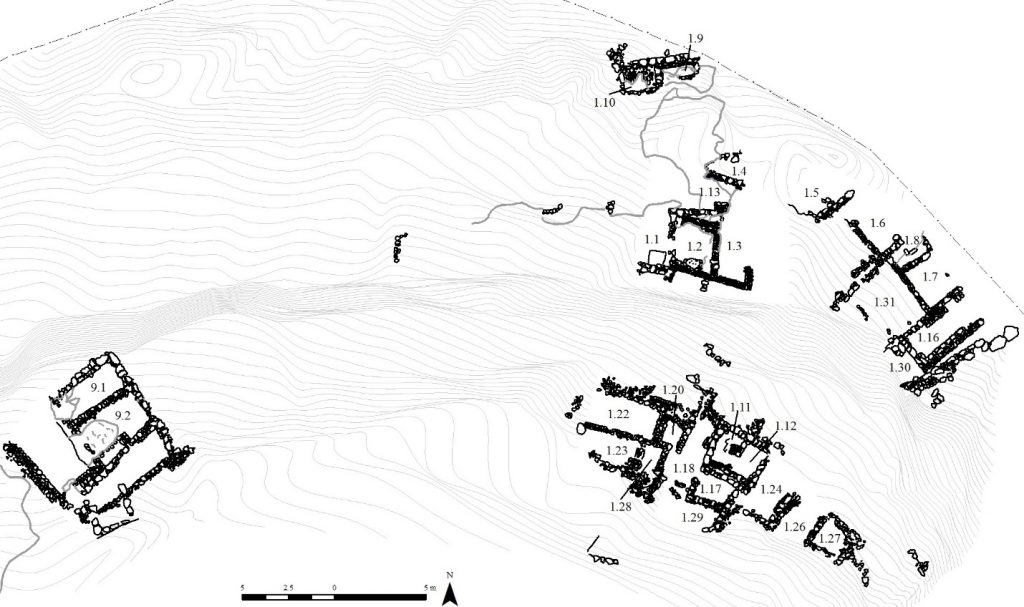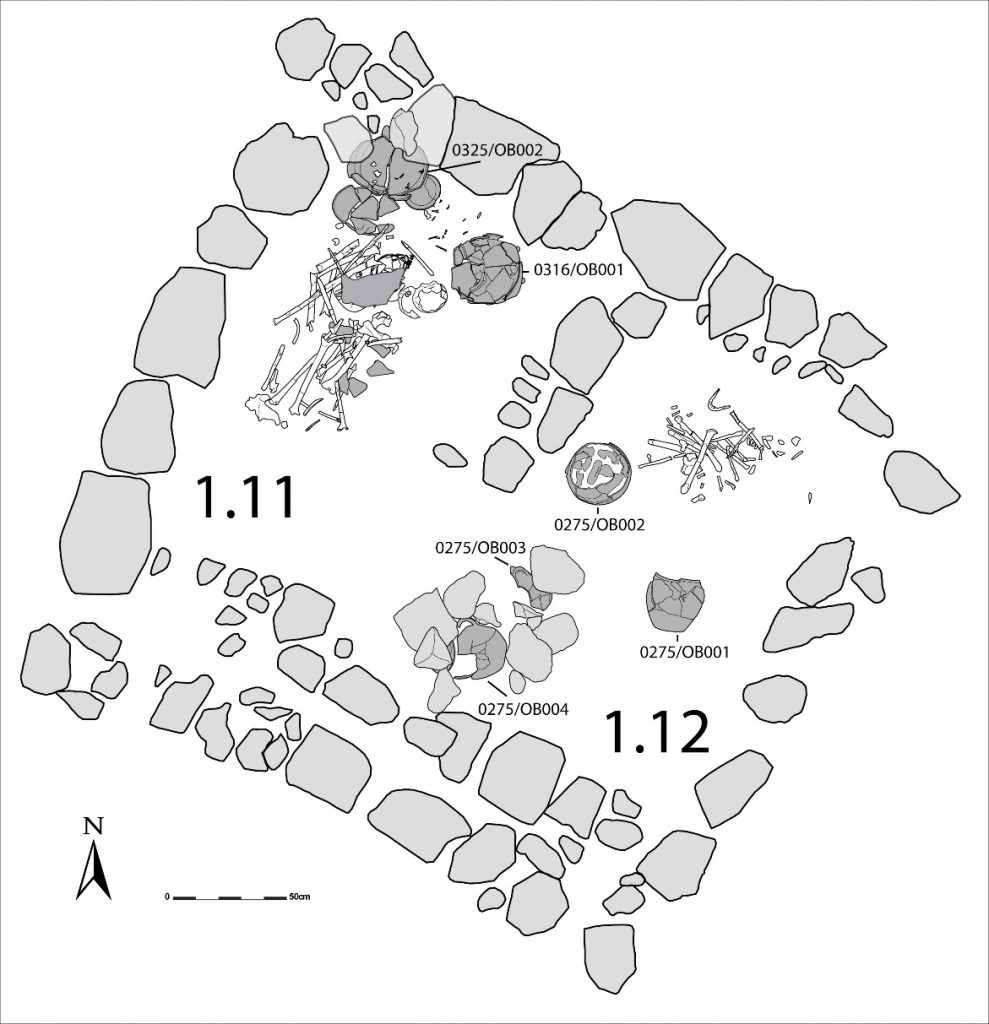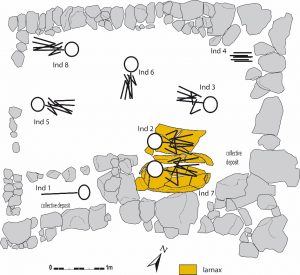Even before excavation started, weathered human bones were identified on the seaward downhill terraces, leaving no doubt as to the presence of a cemetery. Excavation here under the direction of Ilse Schoep between 2007 and 2011 has identified and numbered no less than 30 rectangular compartments (Fig. 1). Overlooking the sea, these form a cemetery of small, rectangular burial structures that are known in literature as house tombs. During the Prepalatial and early Protopalatial periods, house tombs were most common in the northern and eastern regions of the island, in contrast with circular tombs which were mostly (but not exclusively) localized in south-central Crete. From west to east, rectangular tombs have, for instance, been excavated in Archanes, Malia, Istro, Gournia, Vasiliki, Linares, Petras, Palakaistro and Zakros. Some of these burial sites comprise only one or two burial structures, but house tombs are more often grouped in small or larger clusters. The tombs at Sissi were constructed in an agglutinative process, with new compartments being gradually added against existing ones, making it sometimes hard to decide whether adjacent compartments should be considered as belonging to the same tombs.
Most of the rectangular compartments excavated so far are located on two natural terraces on the northeast slope of the hill (Zone 1). However, a large tomb comprising at least four rectangular compartments was discovered on a rocky promontory, ca. 30 m further west (Zone 9), just east of a WW II gun post. This makes it likely that the whole upper terrace between Zone 1 and Zone 9 was covered with burial structures, in which case the cemetery extended over an area of at least 1650 m². Furthermore, badly preserved wall remains on the lower terrace indicate that additional tombs may have existed closer to the sea and to the west of Compartments 1.1 and 1.9-1.10. Zone 9 is better protected from the elements, but the northeast slope of the hill has suffered a lot from wind and sea erosion, with the result that the north and east sectors of the upper terrace and the central and west sector of the lower terrace have been almost completely eroded down to bedrock. Besides Zone 9, the best preserved of the structures excavated so far are Compartments 1.2, 1.9-1.10, 1.16, 1.11-1.12 and 1.17. Excavation has only started to the west of the open space 1.18, but the deposits seem thick enough to be promising.
The tombs follow the orientation of the natural terraces. The rectangular compartments are small in size. The largest is ca. 3.4 m by 1.6-2.7 m, the smallest barely 1 m2. The walls were constructed in rubble masonry, with small and medium-sized fieldstones arranged on one or two faces, sometimes in association with a few larger blocks. Limestone is the most common building material, but sideropetra and sandstone were occasionally used as well. The builders often took advantage of the local topography by incorporating the irregularities of the bedrock in the construction. It is likely that the preserved walls simply formed foundations for elevations in perishable material, and small fragments of burnt mudbrick were for instance collected in Compartment 1.11 and in the open space 1.30. In addition, analysis of micromorphological samples also suggests that at least some of the walls could have been plastered. The natural bedrock was used as a floor in some compartments, whereas a leveling layer of soil (often mixed with sherds or small stones) or a pebble floor was laid out in others. As it is often the case in house tombs, the walls usually preserve no evidence of doorways, suggesting that the compartments were accessed from above – either from the roof or through an opening located higher up in the wall. There are some exceptions, however. There is an opening in the partition wall between Compartment 1.11 and 1.12, and two thresholds in the west and east walls of Compartment 1.7 indicate that the latter communicated with both Compartments 1.8 and 1.16.
The built tombs of Sissi are as a rule poorly preserved and they yielded surprisingly few grave goods in comparison to, for example, the cemeteries of Mochlos and Archanes. Moreover, most of the pottery was found outside the tombs, suggestive for ritual practices taking place in the cemetery. This said, the Sissi Archaeological Project is significantly contributing towards a better understanding of Pre- and Protopalatial funerary practices, mostly as a result of the involvement of physical anthropologists trained in archaeothanatology (also called field anthropology) since its kickoff. Until recently, excavation projects in Crete called in physical anthropologists to study skeletal remains only after excavation had been completed – when calling them in at all. Much information was therefore lost regarding the exact position of osteological remains and hence the treatment of the body. In Sissi, however, physical anthropologists Dr. Isabelle Crevecoeur and Dr. Aurore Schmitt, both of the CNRS in France, are themselves in charge of the excavation and documentation of the burial deposits. During the 2007-2011 campaigns, they were hence able to record unprecedented evidence about the interment sequences in the field.
More specifically, the adoption of an archaeothanatological approach in Sissi has resulted in two particularly significant observations. First of all, Dr. Crevecoeur and Dr. Schmitt found clear evidence of primary burials, hence contradicting the common interpretation of house tombs as just ossuaries. Articulated bodies were deposited in the house tombs of Sissi and left to decompose in situ. It is only later, when new deceased were introduced in the tomb, that the earlier skeletal remains were sometimes disturbed. The process of rearrangement of the bones for practical reasons is known as “reduction”. It must be distinguished from secondary deposits, which occur when partially or completely disarticulated skeletal elements are intentionally transferred from their original locus of decomposition into another locus. In Sissi, secondary deposits have only with certainty been identified in Compartments 1.9 and 9.1. The second major observation made by our archaeothanatologists concerns the treatment of immature individuals, and especially perinatals. Until recently, it was admitted that young children were only rarely buried with the rest of the community. However, the evidence from Sissi tends to suggest that the scarcity of child burials in other cemeteries of rectangular tombs is a consequence of the small size and the fragility of the bones combined with the limited attention paid to skeletal remains in ancient excavations, rather than an actual practice.
Isotopic and DNA samples have also been collected and are currently being analyzed, the first by Argyro Nafplioti (British School at Athens), the second by Marie-France Deguilloux (University of Bordeaux). They are expected to provide information about the local or non-local origin of the community, and to shed some light on kingship ties (or the lack thereof) between the deceased – which could in turn lead to a better understanding of the nature of the social organization of the site during the Pre- and Protopalatial periods.
Current ceramic evidence from the cemetery spans the Early Minoan (EM) IIA (ca. 2650 BC) to Middle Minoan (MM) IIB (ca. 1750 BC) periods. The EM II burial deposits excavated so far are localized on the upper terrace of the northeast slope of the hill. Here, the remains of an EM IIA-B house tomb comprising at least three compartments (1.11, 1.12 and 1.17) was excavated. The structure apparently collapsed, sealing the burials, before being rebuilt in MM IA following a slightly different alignment. The EM II layer in Compartment 1.17 yielded a collective primary burial deposit whereas in Compartment 1.12, the primary burial of a male adult was brought to light, together with four jars containing the remains of perinatals or infants (Fig. 2). Compartment 1.11 yielded two additional perinatal burials in clay containers, as well as a disturbed collective deposit comprising the skeletal remains of a minimum of four individuals (three adults and an adolescent) (Fig. 2). It appears that 1.11 was repeatedly used for primary burials, which resulted in the disturbance of the older skeletal remains. Some of the bones of the first deceased were removed to be deposited elsewhere, and three of the skulls were found clustered in the northwest corner of the room. The bones of one individual were found distributed in such a way that it is safe to assume that the corpse decomposed in a perishable rectangular container. The latter was closed by a terracotta lid, fragments of which were found above the bones.
There is little evidence for the use of the cemetery during the EM III period but the remains of a burial structure beneath the later Compartment 1.2 should be mentioned, as well as the presence in Compartment 1.6 of a primary burial associated with an EM III cup. In addition, a ritual deposit comprising a triton shell, a teapot and two cups was discovered on a pebble floor, under the overhanging bedrock to the south of Compartments 1.2-1.3 (Fig. 3).
In contrast, MM IA, i.e. the last phase of the Prepalatial period, was a period of significant expansion in the cemetery. Compartments 1.11-1.12 were rebuilt and new burial structures were constructed on the lower terrace – e.g. Compartments 1.9-1.10, Compartments 1.7-1.8-1.16, and perhaps Compartments 1.2-1.3 unless it should still be assigned to EM III. It is also in MM IA that Tomb 9 was founded. This event may have significantly changed the spatial relationship between the world of the living and the abode of the dead, given that Tomb 9 is thus far the only burial structure to be intervisible with the settlement. Compartments 9.1, 1.2, 1.7, 1.8 and 1.10 yielded the remains of disturbed primary burials, whereas Compartment 1.9 contained a large secondary deposit comprising the bones of at least 13 individuals (nine adults, one adolescent, two children and one perinatal). These had been carefully organized following the types of bones (Fig. 4, Fig. 5), either long bones or skulls, but the presence of some small bones suggests the transfer of some body parts before decomposition was completed.
Compartment 1.16 stands apart in the context of the cemetery. It was constructed to the east of Compartments 1.7 and 1.31, partly on top of a large pottery deposit that had been placed under the overhanging bedrock. The particular deposit included cups, jugs, bowls, plates, dishes, as well as a broken (and empty) larnax. The good state of preservation of the vessels and the fact that some of them were stacked indicates that the deposit had been carefully placed rather than dumped. Compartment 1.16 (ca. 4.2 by 1.35 m in size) is one of the largest rooms in the cemetery. It was quite carefully built and provided with benches. It yielded pottery but only few bones, suggesting that it was perhaps not used for burials. It is only after the tomb collapsed, during the MM IIA period, that a large secondary deposit of pottery, stones, human and animal bones, and fragments of mudbrick seems to have been dumped here.
Several of the Prepalatial tombs remained in use during the MM IB and MM IIA periods. The best preserved Protopalatial burial deposits were uncovered in Zone 9. Compartment 9.2, for instance, comprised a series of superimposed burial strata that contained the remains of a minimum number of 16 individuals, among which were adults but also immatures (Fig. 6). The compartment yielded evidence for both primary burials and processes of reduction. In addition, missing bones suggest that specific skeletal elements were collected and removed from the tomb after the decomposition of the bodies. Individual 7 was placed in a terracotta larnax, a fragment of which was reused at a later date for the burial of Individual 2. Three of the deceased of Compartment 9.2 were found in a position indicating that their body decomposed in a narrow perishable container, like a basket or a piece of textile. Finally, it may be noted that a golden earring was found on the skull of Individual 8 and a golden stud nearby, personal ornaments that are remarkable given the scarcity of grave goods in general at Sissi.
The upper burial stratum in Compartment 9.1 seems to be MM IIA in date. It contained the remains of seven disturbed primary burials (including one pithos burial), in addition to a secondary deposit. The latter included a single individual’s bones, which were gathered in the southwest corner of the room and covered by large sherds. It is an interesting example of a secondary burial practice in which the individuality of the deceased was, however, preserved. As is the case in Compartment 9.2, the primary burials of Compartment 9.1 testify to repeated events in the course of which earlier deposits were disturbed, displaced, and sometimes removed from the tomb. The same can be said about the MM IIA deposits in Compartments 1.7-1.8.
The pithos burials in Compartment 1.29, which are assigned to the MM IIA phase, are of particular interest (Fig. 7). Three large clay containers have so far been excavated. Instead of containing the remains of unique primary burials, they appear to have been reused on several occasions. Pithos 2, for instance, was associated with the remains of at least four individuals, among which was one child. Upon deposition of a new deceased, most of the bones of the former deceased were collected and arranged outside the vessel. The evidence from Compartment 1.29 also illustrate that fragments of one or several pithoi could be used as burial containers in place of complete vessels.
Most of the tombs went out of use before the beginning of the MM IIB period. Late Protopalatial pottery was found in Compartments 9.1 and 9.2, but not in association with skeletal remains. The latest burial excavated so far in the cemetery is that of a mature woman. Her body was inserted in a pithos which was sunk into the pebble floor of the old Compartment 1.2. The cemetery was then deserted, not to be reused again. Where the inhabitants of the hilltop were buried afterwards remains unknown, with the exception of two immatures that were discovered under the floor of the Neopalatial Building BC.
Sylviane Déderix, Isabelle Crevecoeur & Aurore Schmitt
Bibliography:
Crevecoeur, I. and Schmitt, A. 2009. Etude archéo-anthropologique de la nécropole (Zone 1). In: Driessen, J., Schoep, I., Carpentier, F., Crevecoeur, I., Devolder, M., Gaignerot-Driessen, F., Fiasse, H., Hacigüzeller, P., Jusseret, S., Langohr, C., Letesson, Q. and Schmitt, A. Excavations at Sissi. Preliminary Report of the 2007-2008 Campaigns. Aegis 1. Louvain-la-Neuve: Presses Universitaires de Louvain, p. 45-56.
Crevecoeur, I., Schmitt, A. and Schoep, I. 2015. An Archaeothanatological Approach to the Study of Minoan Funerary Practices: Case-Studies from the Early and Middle Minoan Cemetery at Sissi, Crete. Journal of Field Archaeology 40(3), p. 283-299.
Schmitt, A., Crevecoeur, I., Gilon, A. and Schoep, I., 2013. Apparition des inhumations individuelles en pithos à l’âge du Bronze en Crète : reflet d’une mutation sociale ? In : Transition, ruptures et continuité durant la Préhistoire. XXVIIe congrès préhistorique de France, Bordeaux-Les Eyzies, 2010. Volume 1. Paris : Société préhistorique française, p. 271-284.
Schoep, I. 2009. The excavation of the Cemetery (Zone 1). In: Driessen, J., Schoep, I., Carpentier, F., Crevecoeur, I., Devolder, M., Gaignerot-Driessen, F., Fiasse, H., Hacıgüzeller, P., Jusseret, S., Langohr, C., Letesson, Q. and Schmitt, A. Excavations at Sissi. Preliminary Report of the 2007-2008 Campaigns. Aegis 1. Louvain-la-Neuve: Presses Universitaires de Louvain, p. 57-94.
Schoep, I. Forthcoming. The House-Tomb in Context: Assessing Mortuary Behaviour in Northeast Crete. In: Relaki, M. and Papadatos, Y. (eds). From the Foundations to the Legacy of Minoan Society, Sheffield Round Table in Honour of Professor Keith Branigan.
Schoep, I., Schmitt, A. and Crevecoeur, I. 2011. The Cemetery at Sissi. In: Driessen, J., Schoep, I., Carpentier, F., Crevecoeur, I., Devolder, M., Gaignerot-Driessen, F., Hacigüzeller, P., Isaakidou, V., Jusseret, S., Langohr, C., Letesson, Q. and Schmitt, A. Excavations at Sissi, II. Preliminary Report on the 2009-2010 Campaigns. Aegis 4. Louvain-la-Neuve: Presses Universitaires de Louvain, p. 41-67.
Schoep, I., Schmitt, A., Crevecoeur, I., and Déderix, S. 2012. The Cemetery at Sissi. In: Driessen, J., Schoep, I., Anastasiadou, M., Carpentier, F., Crevecoeur, I., Déderix, S., Devolder, M., Gaignerot-Driessen, F., Jusseret, S., Langohr, C., Letesson, Q., Liard, F., Schmitt, A, Tsoraki, C. and Veropoulidou, R. Excavations at Sissi, III. Preliminary Report on the 2011 Campaign. Aegis 6. Louvain-la-Neuve: Presses Universitaires de Louvain, p. 27-51.






